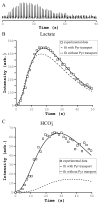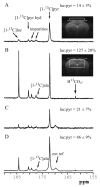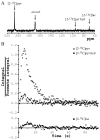In vivo 13C spectroscopy in the rat brain using hyperpolarized [1-(13)C]pyruvate and [2-(13)C]pyruvate
- PMID: 20685141
- PMCID: PMC2939207
- DOI: 10.1016/j.jmr.2010.07.006
In vivo 13C spectroscopy in the rat brain using hyperpolarized [1-(13)C]pyruvate and [2-(13)C]pyruvate
Abstract
The low sensitivity of 13C spectroscopy can be enhanced using dynamic nuclear polarization. Detection of hyperpolarized [1-(13)C]pyruvate and its metabolic products has been reported in kidney, liver, and muscle. In this work, the feasibility of measuring 13C signals of hyperpolarized 13C metabolic products in the rat brain in vivo following the injection of hyperpolarized [1-(13)C]pyruvate and [2-(13)C]pyruvate is investigated. Injection of [2-(13)C]pyruvate led to the detection of [2-(13)C]lactate, but no other downstream metabolites such as TCA cycle intermediates were detected. Injection of [1-(13)C]pyruvate enabled the detection of both [1-(13)C]lactate and [13C]bicarbonate. A metabolic model was used to fit the hyperpolarized 13C time courses obtained during infusion of [1-(13)C]pyruvate and to determine the values of VPDH and VLDH.
Copyright © 2010 Elsevier Inc. All rights reserved.
Figures






Similar articles
-
Feasibility of using hyperpolarized [1-13C]lactate as a substrate for in vivo metabolic 13C MRSI studies.Magn Reson Imaging. 2008 Jul;26(6):721-6. doi: 10.1016/j.mri.2008.01.002. Epub 2008 May 13. Magn Reson Imaging. 2008. PMID: 18479878 Free PMC article.
-
Using [1-(13) C]lactic acid for hyperpolarized (13) C MR cardiac studies.Magn Reson Med. 2015 Jun;73(6):2087-93. doi: 10.1002/mrm.25354. Epub 2014 Jul 9. Magn Reson Med. 2015. PMID: 25046652
-
In vivo carbon-13 dynamic MRS and MRSI of normal and fasted rat liver with hyperpolarized 13C-pyruvate.Mol Imaging Biol. 2009 Nov-Dec;11(6):399-407. doi: 10.1007/s11307-009-0218-z. Epub 2009 May 8. Mol Imaging Biol. 2009. PMID: 19424761 Free PMC article.
-
Imaging pH with hyperpolarized 13C.NMR Biomed. 2011 Oct;24(8):1006-15. doi: 10.1002/nbm.1742. Epub 2011 Aug 3. NMR Biomed. 2011. PMID: 21812047 Review.
-
Hyperpolarized MRI - An Update and Future Perspectives.Semin Nucl Med. 2022 May;52(3):374-381. doi: 10.1053/j.semnuclmed.2021.09.001. Epub 2021 Nov 14. Semin Nucl Med. 2022. PMID: 34785033 Review.
Cited by
-
Multinuclear MRI in Drug Discovery.Molecules. 2022 Oct 1;27(19):6493. doi: 10.3390/molecules27196493. Molecules. 2022. PMID: 36235031 Free PMC article. Review.
-
Biomedical Applications of the Dynamic Nuclear Polarization and Parahydrogen Induced Polarization Techniques for Hyperpolarized 13C MR Imaging.Magn Reson Med Sci. 2021 Mar 1;20(1):1-17. doi: 10.2463/mrms.rev.2019-0094. Epub 2019 Dec 27. Magn Reson Med Sci. 2021. PMID: 31902907 Free PMC article. Review.
-
Hyperpolarization without persistent radicals for in vivo real-time metabolic imaging.Proc Natl Acad Sci U S A. 2013 Nov 5;110(45):18064-9. doi: 10.1073/pnas.1314928110. Epub 2013 Oct 21. Proc Natl Acad Sci U S A. 2013. PMID: 24145405 Free PMC article.
-
DNP by thermal mixing under optimized conditions yields >60,000-fold enhancement of 89Y NMR signal.J Am Chem Soc. 2011 Jun 8;133(22):8673-80. doi: 10.1021/ja201880y. Epub 2011 May 13. J Am Chem Soc. 2011. PMID: 21539398 Free PMC article.
-
Application of hyperpolarized [1-¹³C]lactate for the in vivo investigation of cardiac metabolism.NMR Biomed. 2012 Oct;25(10):1119-24. doi: 10.1002/nbm.2778. Epub 2012 Jan 25. NMR Biomed. 2012. PMID: 22278751 Free PMC article.
References
-
- Gruetter R. In vivo 13C NMR studies of compartmentalized cerebral carbohydrate metabolism. Neurochem Int. 2002;41:143–54. - PubMed
-
- Frossati G. Polarization of 3He, D2 and (eventually) 129Xe using low temperatures and high magnetic fields. J Low Temp Phys. 1998;111:521–532.
-
- Bouchiat MA, Carver TR, Varnum CM. Nuclear Polarization in 3He gas induced by optical pymping and dipolar exchange. Phys Rev Lett. 1960;5:373–375.
-
- Grover BC. Noble-Gas Nmr Detection through Noble-Gas-Rubidium Hyperfine Contact Interaction. Phys Rev Lett. 1978;40:391–392.
-
- Bowers CR, Weitekamp DP. Transformation of symmetrization order to nuclear-spin magnetization by chemical reaction and nuclear magnetic resonance. Phys Rev Lett. 1986;57:2645–2648. - PubMed
Publication types
MeSH terms
Substances
Grants and funding
LinkOut - more resources
Full Text Sources

